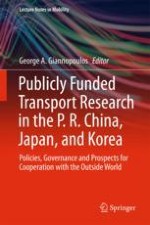
2018 | OriginalPaper | Chapter
The Case for Transport Research Cooperation with China, Japan, Korea—Rationale for This Book and Summary of Its Findings
Authors : George A. Giannopoulos, John F. Munro
Published in: Publicly Funded Transport Research in the P. R. China, Japan, and Korea
Publisher: Springer International Publishing
Activate our intelligent search to find suitable subject content or patents.
Select sections of text to find matching patents with Artificial Intelligence. powered by
Select sections of text to find additional relevant content using AI-assisted search. powered by